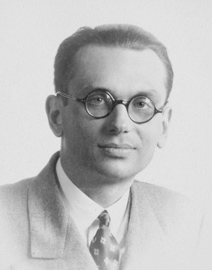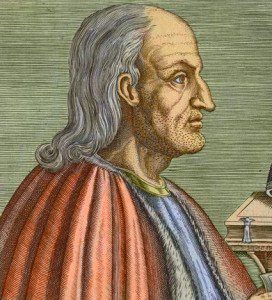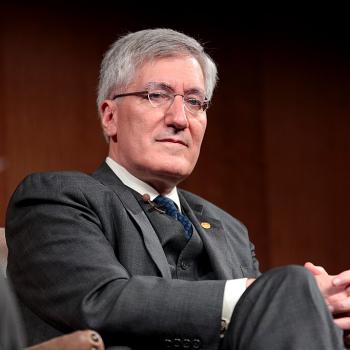
 The great mathematician and logician Kurt Gödel, who died in 1978, left behind a series of equations that purport to prove the existence of God.
The great mathematician and logician Kurt Gödel, who died in 1978, left behind a series of equations that purport to prove the existence of God.
As I understand it (and I don’t understand the math!), the equations test the validity of St. Anselm’s ontological argument for God’s existence, which defines God as the greatest being that can be conceived. Such a being would have to have the property of existence; otherwise, we could conceive of a greater being, namely, one that exists. And that one would be God.
This sounds like a language game, but philosophers have wrestled with the argument for centuries, finding it more formidable than it might appear on the surface.
Now two European computer scientists have run Gödel’s mathematical proof on a computer and found it valid.
You do the math:
“Ax. 1. {P(φ)∧◻∀x[φ(x)→ψ(x)]} →P(ψ)Ax. 2.P(¬φ)↔¬P(φ)Th. 1.P(φ)→◊∃x[φ(x)]Df. 1.G(x)⟺∀φ[P(φ)→φ(x)]Ax. 3.P(G)Th. 2.◊∃xG(x)Df. 2.φ ess x⟺φ(x)∧∀ψ{ψ(x)→◻∀y[φ(y)→ψ(y)]}Ax. 4.P(φ)→◻P(φ)Th. 3.G(x)→G ess xDf. 3.E(x)⟺∀φ[φ ess x→◻∃yφ(y)]Ax. 5.P(E)Th. 4.◻∃xG(x)”.
After the jump, a news story on the computer scientists’ work. I also include Gödel’s proof and a link explaining the above mathematical notation.
From Sean Martin, Scientists run calculations to PROVE the existence of God | Science | News | Daily Express:
Two computer scientists say they proved that there is a holy supreme force after confirming the equations.
In 1978, mathematician Kurt Gödel died and left behind a long and complex theory based on modal logic.
Dr Gödel’s model uses mathematical equations that are extremely complicated, but the essence is that no greater power than God can be conceived, and if he or she is believed as a concept then he or she can exist in reality.
Or as Dr Gödel put it through his equations: “Ax. 1. {P(φ)∧◻∀x[φ(x)→ψ(x)]} →P(ψ)Ax. 2.P(¬φ)↔¬P(φ)Th. 1.P(φ)→◊∃x[φ(x)]Df. 1.G(x)⟺∀φ[P(φ)→φ(x)]Ax. 3.P(G)Th. 2.◊∃xG(x)Df. 2.φ ess x⟺φ(x)∧∀ψ{ψ(x)→◻∀y[φ(y)→ψ(y)]}Ax. 4.P(φ)→◻P(φ)Th. 3.G(x)→G ess xDf. 3.E(x)⟺∀φ[φ ess x→◻∃yφ(y)]Ax. 5.P(E)Th. 4.◻∃xG(x)”.
You get it, right?
But two computer scientists have used computers to run such complicated [mathematics] which they say confirms that the equation does indeed add up.
Here is Gödel’s proof:
Definition 1: x is God-like if and only if x has as essential properties those and only those properties which are positive
Definition 2: A is an essence of x if and only if for every property B, x has B necessarily if and only if A entails B
Definition 3: x necessarily exists if and only if every essence of x is necessarily exemplified
Axiom 1: If a property is positive, then its negation is not positive
Axiom 2: Any property entailed by—i.e., strictly implied by—a positive property is positive
Axiom 3: The property of being God-like is positive
Axiom 4: If a property is positive, then it is necessarily positive
Axiom 5: Necessary existence is positive
Axiom 6: For any property P, if P is positive, then being necessarily P is positive
Theorem 1: If a property is positive, then it is consistent, i.e., possibly exemplified
Corollary 1: The property of being God-like is consistent
Theorem 2: If something is God-like, then the property of being God-like is an essence of that thing
Theorem 3: Necessarily, the property of being God-like is exemplified
For Gödel’s mathematical notations, go here.
What Wikipedia says about Gödel’s religious beliefs (Note the Lutheran connection!):
Religious views[edit]
Gödel was a convinced theist, in the Christian tradition.[28] He held the notion that God was personal.
He believed firmly in an afterlife, stating: “Of course this supposes that there are many relationships which today’s science and received wisdom haven’t any inkling of. But I am convinced of this [the afterlife], independently of any theology.” It is “possible today to perceive, by pure reasoning” that it “is entirely consistent with known facts.” “If the world is rationally constructed and has meaning, then there must be such a thing [as an afterlife].”[29]
In an unmailed answer to a questionnaire, Gödel described his religion as “baptized Lutheran (but not member of any religious congregation). My belief is theistic, not pantheistic, following Leibniz rather than Spinoza.”[30] Describing religion(s) in general, Gödel said: “Religions are, for the most part, bad—but religion is not”.[31] According to his wife Adele, “Gödel, although he did not go to church, was religious and read the Bible in bed every Sunday morning”,[32] while of Islam, he said, “I like Islam: it is a consistent [or consequential] idea of religion and open-minded”.[33]
Photo of Kurt Gödel by unknown – http://www.arithmeum.uni-bonn.de/en/events/285, https://en.wikipedia.org/w/index.php?curid=43426215. Public Domain
Portrait of St. Anselm of Canterbury, Public Domain, via Wikimedia Commons











